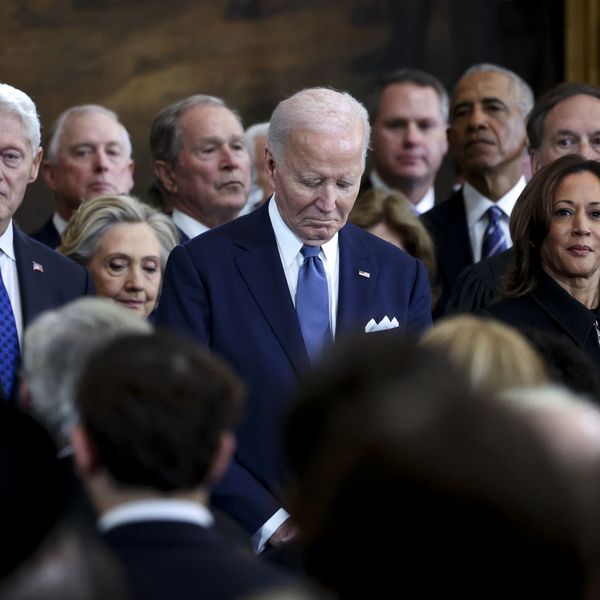A New York Times piece (8/24/14) about Michael Brown, the unarmed teenager shot dead in Ferguson this month by police officer Darren Wilson, has been the subject of harsh criticism because of its declaration that Brown was "no angel." In the version that ran in today's print edition, the Times' John Eligon writes:
Michael Brown, 18, due to be buried on Monday, was no angel, with public records and interviews with friends and family revealing both problems and promise in his young life.
A Times editor defended this assessment of Brown by explaining that it was a reference back to the opening scene of the piece, where Brown talks to his stepfather about seeing the image of an angel in a storm cloud. Of course, this reference was plainly obvious to anyone reading the piece.
The question is whether, on the day Brown's family and friends are gathering for his funeral, the paper should be calling his character into question with observations like these:
He lived in a community that had rough patches, and he dabbled in drugs and alcohol. He had taken to rapping in recent months, producing lyrics that were by turns contemplative and vulgar. He got into at least one scuffle with a neighbor.
The "scuffle" references an altercation where someone threw a punch at Brown, who apparently did not hit back. The paper also noted that he "occasionally smoked marijuana and drank alcohol."
To be fair, the piece also presented other aspects of Brown's personality-telling readers that he "regularly flashed a broad smile that endeared those around him."
The observation that Brown is "no angel" is perhaps another way of saying that he was a teenager. But the way the Times raised this struck many people as wholly inappropriate-though, perhaps, not entirely surprising; a few days before the Times piece, cartoonist Matt Bors captured this media tendency all too perfectly.
As Jack Mirkinson noted at the Huffington Post (8/25/14) , the Times (8/24/14) also presents a profile of Darren Wilson, the Ferguson police officer who killed Brown, in today's paper. His standing in relation to the angels is not discussed, nor do we know what kind of music he liked or whether he smoked pot. All we can piece together is that, according to some, he is a "well-mannered, relatively soft-spoken, even bland person...a reaction to a turbulent youth."
Almost a week ago (8/19/14), the Times was raising other questions about Brown-specifically, the actions he took that could have cost him his life. The Times' Frances Robles and Michael Schmidt explained that "witnesses have given investigators sharply conflicting accounts of the killing." But to critics of that piece, the Times was giving too much weight to accounts that suggested Brown had in some way attacked the officer.
According to the Times, witness accounts are consistent up to a point: There was some sort of confrontation near Wilson's car, a gunshot is heard, Brown runs away from the car and is shot several times.
But the Times sees some important differences in the witness accounts:
But on the crucial moments that followed, the accounts differ sharply, officials say. Some witnesses say that Mr. Brown, 18, moved toward Officer Wilson, possibly in a threatening manner, when the officer shot him dead. But others say that Mr. Brown was not moving and may even have had his hands up when he was killed.
Being shot after running away from a police officer is very different from being shot as you are about to attack that police officer. So where is the Times getting these accounts? That is somewhat murky:
The accounts of what witnesses have told local and federal law enforcement authorities come from some of those witnesses themselves, law enforcement authorities and others in Ferguson. Many spoke on the condition of anonymity because they did not want to be identified discussing a continuing investigation.
So is it possible that the accounts that justify Brown's shooting come from "law enforcement authorities"? That could very well be the case. As the Times account continues:
Several witnesses have told investigators that Mr. Brown stopped and turned around with his arms up.
According to his account to the Ferguson police, Officer Wilson said that Mr. Brown had lowered his arms and moved toward him, law enforcement officials said. Fearing that the teenager was going to attack him, the officer decided to use deadly force. Some witnesses have backed up that account. Others, however-including Mr. Johnson-have said that Mr. Brown did not move toward the officer before the final shots were fired.
From that, a careful reader might conclude that the witness who gives the account most helpful to Wilson is Wilson himself. That could be why the piece was singled out by MSNBC host Lawrence O'Donnell (8/20/14), who summed up his criticism this way:
And in a profound and uncharacteristic flash of irresponsibility, the Times fails to produce a single witness who sharply conflicts with any other witness in the article.
Times public editor Margaret Sullivan (8/21/14) reached a similar conclusion:
The story goes on to quote, by name, two eyewitnesses who say that Mr. Brown had his hands up as he was fired on. As for those who posit that Mr. Brown was advancing on the officer who was afraid the teenager was going to attack him, the primary source on this seems to be what Officer Wilson told his colleagues on the police force.
Times deputy national editor James Dao defended the piece to Sullivan, at one point calling it "fair and balanced"- a phrase that rings a bell, and not in a good way.


